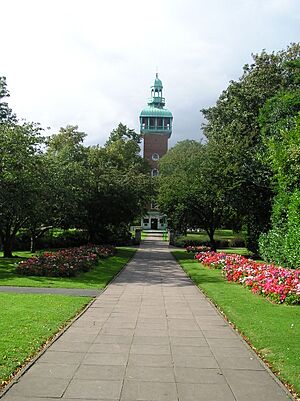Loughborough Carillon facts for kids
The Loughborough Carillon is a tall tower with many bells, located in Loughborough, England. It's a special war memorial that helps us remember brave soldiers. You can find it in Queen's Park, and it's so tall – about 152 feet (46 m) high – that you can see it from far away!
This amazing tower was planned in 1919 and finished in 1923. It was the very first carillon in England to have four octaves of bells! The idea for carillons like this came from Belgium, a country where many British soldiers fought and lost their lives during World War I (also known as the Great War) from 1914 to 1918.
The Carillon was designed by a famous architect named Sir Walter Tapper. Today, it's a listed building (Grade II), which means it's an important historical structure. All 47 of its bells were made right there in Loughborough at the John Taylor Bell Foundry. The building itself was constructed by William Moss and Sons Ltd.
The Carillon was officially opened on July 22, 1923. Important people like Theodore Woods, who was the Bishop of Peterborough, and Field-Marshal William Robertson were there. A famous carillon player, Jef Denyn, played the bells. Even the famous composer Edward Elgar wrote a special piece of music called Memorial Chimes for the event! The original music sheet for this piece was found again in 2012.
Contents
What is a Carillon?
A carillon is a musical instrument made of many bells, usually found in a tower. A special musician called a carillonneur plays the bells using a keyboard and pedals. Each bell makes a different note, allowing the carillonneur to play melodies and songs. It's like a giant, beautiful bell orchestra!
Visiting the Carillon and Museum
You can hear the beautiful sounds of the Carillon during special concerts. These recitals happen every Thursday and Sunday afternoon from 1:00 PM to 2:00 PM throughout the summer months. It's a wonderful way to experience the music of the bells.
The War Memorial Museum
Inside the Carillon tower, there's a special place called the War Memorial Museum. It has three floors filled with interesting items from the military. You can see artifacts from different parts of the armed forces and learn about both World War I and World War II. It's a great way to understand more about history and the people who served.
To go up the tower and see the museum, you need to climb a long spiral staircase. Because of this, only the ground floor is accessible for people with disabilities.
The Carillon Bells
The Loughborough Carillon has 47 bells, and each one has a different size and weight! The smallest bells are very light, weighing only a few kilograms. The largest bell, called the Bourdon bell, is much heavier, weighing over 4,000 kilograms! Imagine how powerful its sound must be.
| Bell | Weight | |
|---|---|---|
| hundredweights-quarters-pounds | (metric equivalent) | |
| Treble | 0-0-14 | (6 kg) |
| 2 | 0-0-13 | (6 kg) |
| 3 | 0-0-13 | (6 kg) |
| 4 | 0-0-12 | (5 kg) |
| 5 | 0-0-15 | (7 kg) |
| 6 | 0-0-15 | (7 kg) |
| 7 | 0-0-13 | (6 kg) |
| 8 | 0-0-12 | (5 kg) |
| 9 | 0-0-16 | (7 kg) |
| 10 | 0-0-18 | (8 kg) |
| 11 | 0-0-19 | (9 kg) |
| 12 | 0-0-24 | (11 kg) |
| 13 | 0-0-27 | (12 kg) |
| 14 | 0-1-4 | (15 kg) |
| 15 | 0-1-8 | (16 kg) |
| 16 | 0-1-15 | (20 kg) |
| 17 | 0-1-16 | (20 kg) |
| 18 | 0-1-20 | (22 kg) |
| 19 | 0-2-9 | (29 kg) |
| 20 | 0-2-20 | (34 kg) |
| 21 | 0-3-16 | (45 kg) |
| 22 | 1-0-2 | (52 kg) |
| 23 | 1-0-21 | (60 kg) |
| 24 | 1-1-16 | (71 kg) |
| 25 | 1-2-23 | (87 kg) |
| 26 | 1-3-8 | (93 kg) |
| 27 | 2-0-6 | (104 kg) |
| 28 | 2-1-10 | (119 kg) |
| 29 | 2-3-13 | (146 kg) |
| 30 | 3-2-4 | (180 kg) |
| 31 | 3-3-25 | (202 kg) |
| 32 | 4-3-17 | (249 kg) |
| 33 | 5-1-9 | (271 kg) |
| 34 | 6-0-14 | (311 kg) |
| 35 | 7-1-8 | (372 kg) |
| 36 | 8-3-8 | (448 kg) |
| 37 | 10-1-24 | (532 kg) |
| 38 | 12-1-23 | (633 kg) |
| 39 | 15-1-16 | (782 kg) |
| 40 | 17-3-21 | (911 kg) |
| 41 | 21-2-0 | (1092 kg) |
| 42 | 25-3-25 | (1320 kg) |
| 43 | 31-0-0 | (1575 kg) |
| 44 | 34-1-6 | (1743 kg) |
| 45 | 40-3-25 | (2082 kg) |
| 46 | 60-1-6 | (3064 kg) |
| Bourdon | 82-3-16 | (4211 kg) |
See also
- List of carillons of the British Isles


